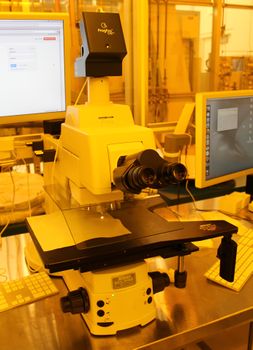Microscopes
Jump to navigation
Jump to search
|
Nikon
The lab currently has 3 Nikon Microscopes (Microscopes #2, #3 & #4). These are located in bays 6 and 7.
The scopes have 3rd party cameras that are connected to computers via Jenoptik ProgRes software which allows users to digitally capture images through the microscope and make calibrated measurements.
Microscope #2: Nikon Optiphot 200 (Bay 7)
- Trinocular: Ocular Binoc. + Camera (Simultaneous)
- ProgRes video/photo capture & user-editable calibrated measurement
- Objectives: 5x, 10x, 20x, 50x, 100x, 150x
- Filters: Green, ND
- Bright/Dark Field
- Differential Interference Contrast (DIC/Nomarski)
- The DIC prism is installed on each objective and can't be removed, so even regular microscope images suffer from a slight double-image
- Top Reflected Illumination (Episcopic)
Microscope #3: Nikon Eclipse L200 (Bay 6)
- Manual for Nikon Eclipse L200D
- Trinocular: Binoc. + Camera (Mutually Exclusive)
- ProgRes video/photo capture & user-editable calibrated measurement
- Objectives: 5x, 10x, 20x, 50x, 100x, 150x
- Filters: Green, ND
- Bright/Dark Field
- Differential Interference Contrast (DIC/Nomarski)
- Top Reflected Illumination (Episcopic)
Microscope #4: Nikon Eclipse L200D (Bay 6)
- Trinocular: Binoc. + Camera (Mutually Exclusive)
- ProgRes video/photo capture & user-editable calibrated measurement
- Objectives: 5x, 10x, 20x, 50x, 100x, 150x
- Filters: Green, ND
- Bright/Dark Field
- Differential Interference Contrast (DIC/Nomarski)
- Top Reflected (Episcopic) & Bottom Transmission (Diascopic) Illumination
Olympus
The lab has two general purpose Olympus microscopes, and two specialized microscopes that require training to use, although both of these can also be used for general imaging.
Microscope #1: Olympus Optiphot-2 (Bay 3)
- To be added
Fluorescence Microscope: Olympus MX51 (Bay 6)
- See the wiki page for the Olympus MX51 for full details
- Trinocular: Binoc. + Camera (Simultaneous)
- Native Olympus Stream Software:
- Photo/video capture
- Calibrated measurement (calibrations locked)
- Objectives: 5x, 10x, 20x, 50x, 100x, 150x
- Filters: Green, ND
- Bright/Dark Field
- Differential Interference Contrast (DIC/Nomarski)
- Top (Episcopic) & Bottom (Diascopic) Illumination
- Three Fluorescence Filters (requires training, see main tool page for specs.)
DUV Microscope: Olympus MX61A-DUV (Bay 7)
Please see the main tool page for detailed info on this microscope: Deep UV Optical Microscope (Olympus)
YOU ARE REQUIRED TO GET TRAINED on this tool before you are allowed to use it! Please contact the Tool Owner to get training.
- Motorized Stage + Objective Turret
- Trinocular: Binoc. + Camera (Simultaneous)
- Objectives: 5x, 10x, 20, 50x, 100x, DUV-100x
- Filters: to be added
- Native Olympus MX61 Software control & Camera
- Calibrated measurements (calibrations locked)
- Z (focus) measurement via motorized stage height
- Deep-UV Light source + DUV Camera
- DUV-100x sub-micron imaging/measurement
Olympus LEXT Confocal Microscope (Bay 4)
See the main tool page for complete info: Laser Scanning Confocal M-scope (Olympus LEXT)
YOU ARE REQUIRED TO GET TRAINED on this tool before you are allowed to use it! Please contact the Tool Owner to get training.
- Motorized stage + Objective Turret
- 100mm wafer stage
- Native Olympus OLS2000 Software & Built-In Camera:
- Calibrated measurement (calibrations locked)
- Image stitching capabilities
- 3D Laser-Scanning Confocal Microscopy capability:
- 3D Topographical measurement (optical profilometry)
- Surface roughness estimations (large roughness)
- Thin-Film Film-Thickness Measurements (thicker films)
Documentation
- Microscope Training - General procedures and info for using our microscopes
